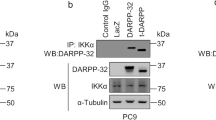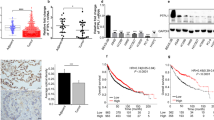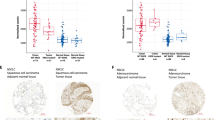Abstract
Protein kinase Cι (PKCι) drives transformed growth of non-small cell lung cancer (NSCLC) cells through the Rho family GTPase Rac1. We show here that PKCι activates Rac1 in NSCLC cells by formation of a PKCι–Par6α complex that drives anchorage-independent growth and invasion through activation of matrix metalloproteinase-10 (MMP-10) expression. RNAi-mediated knockdown of PKCι, Par6α or Rac1 expression inhibits NSCLC transformation and MMP-10 expression in vitro. Expression of wild-type Par6α in Par6α-deficient cells restores transformation and MMP-10 expression, whereas expression of Par6α mutants that either cannot bind PKCι (Par6α-K19A) or couple to Rac1 (Par6α-ΔCRIB) do not. Knockdown of MMP-10 expression blocks anchorage-independent growth and invasion of NSCLC cells and addition of catalytically active MMP-10 to PKCι- or Par6α-deficient cells restores anchorage-independent growth and invasion. Dominant-negative PKCι inhibits tumorigenicity and MMP-10 expression in subcutaneous NSCLC tumors. MMP-10 and PKCι are coordinately overexpressed in primary NSCLC tumors, and tumor MMP-10 expression predicts poor survival in NSCLC patients. Our data define a PKCι–Par6α–Rac1 signaling axis that drives anchorage-independent growth and invasion of NSCLC cells through induction of MMP-10 expression.
This is a preview of subscription content, access via your institution
Access options
Subscribe to this journal
Receive 50 print issues and online access
$259.00 per year
only $5.18 per issue
Buy this article
- Purchase on Springer Link
- Instant access to full article PDF
Prices may be subject to local taxes which are calculated during checkout







Similar content being viewed by others
References
Bodey B, Bodey Jr B, Groger AM, Siegel SE, Kaiser HE . (2001). Invasion and metastasis: the expression and significance of matrix metalloproteinases in carcinomas of the lung. In Vivo 15: 175–180.
Cho NH, Hong KP, Hong SH, Kang S, Chung KY, Cho SH . (2004). MMP expression profiling in recurred stage IB lung cancer. Oncogene 23: 845–851.
Delebecq TJ, Porte H, Zerimech F, Copin MC, Gouyer V, Dacquembronne E et al. (2000). Overexpression level of stromelysin 3 is related to the lymph node involvement in non-small cell lung cancer. Clin Cancer Res 6: 1086–1092.
Egeblad M, Werb Z . (2002). New functions for the matrix metalloproteinases in cancer progression. Nat Rev Cancer 2: 161–174.
Erdogan E, Lamark T, Stallings-Mann M, Lee J, Pellecchia M, Thompson EA et al. (2006). Aurothiomalate inhibits transformed growth by targeting the PB1 domain of protein kinase Ciota. J Biol Chem 281: 28450–28459.
Fields AP, Regala RP . (2007). Protein kinase C iota: human oncogene, prognostic marker and therapeutic target. Pharmacol Res 55: 487–497.
Garber ME, Troyanskaya OG, Schluens K, Petersen S, Thaesler Z, Pacyna-Gengelbach M et al. (2001). Diversity of gene expression in adenocarcinoma of the lung. Proc Natl Acad Sci USA 98: 13784–13789.
Gill JH, Kirwan IG, Seargent JM, Martin SW, Tijani S, Anikin VA et al. (2004). MMP-10 is overexpressed, proteolytically active, and a potential target for therapeutic intervention in human lung carcinomas. Neoplasia 6: 777–785.
Imoto I, Pimkhaokham A, Fukuda Y, Yang ZQ, Shimada Y, Nomura N et al. (2001). SNO is a probable target for gene amplification at 3q26 in squamous-cell carcinomas of the esophagus. Biochem Biophys Res Commun 286: 559–565.
Impola U, Uitto VJ, Hietanen J, Hakkinen L, Zhang L, Larjava H et al. (2004). Differential expression of matrilysin-1 (MMP-7), 92 kD gelatinase (MMP-9), and metalloelastase (MMP-12) in oral verrucous and squamous cell cancer. J Pathol 202: 14–22.
Joberty G, Petersen C, Gao L, Macara IG . (2000). The cell-polarity protein Par6 links Par3 and atypical protein kinase C to Cdc42. Nat Cell Biol 2: 531–539.
Kleinman HK, Martin GR . (2005). Matrigel: basement membrane matrix with biological activity. Semin Cancer Biol 15: 378–386.
Kren L, Goncharuk VN, Krenova Z, Stratil D, Hermanova M, Skrickova J et al. (2006). Expression of matrix metalloproteinases 3, 10 and 11 (stromelysins 1, 2 and 3) and matrix metalloproteinase 7 (matrilysin) by cancer cells in non-small cell lung neoplasms. Clinicopathologic studies. Cesk Patol 42: 16–19.
Mathew R, Khanna R, Kumar R, Mathur M, Shukla NK, Ralhan R . (2002). Stromelysin-2 overexpression in human esophageal squamous cell carcinoma: potential clinical implications. Cancer Detect Prev 26: 222–228.
Muller D, Breathnach R, Engelmann A, Millon R, Bronner G, Flesch H et al. (1991). Expression of collagenase-related metalloproteinase genes in human lung or head and neck tumours. Int J Cancer 48: 550–556.
Noda Y, Takeya R, Ohno S, Naito S, Ito T, Sumimoto H . (2001). Human homologues of the Caenorhabditis elegans cell polarity protein PAR6 as an adaptor that links the small GTPases Rac and Cdc42 to atypical protein kinase C. Genes Cells 6: 107–119.
O-Charoenrat P, Rhys-Evans PH, Eccles SA . (2001). Expression of matrix metalloproteinases and their inhibitors correlates with invasion and metastasis in squamous cell carcinoma of the head and neck. Arch Otolaryngol Head Neck Surg 127: 813–820.
Osada H, Takahashi T . (2002). Genetic alterations of multiple tumor suppressors and oncogenes in the carcinogenesis and progression of lung cancer. Oncogene 21: 7421–7434.
Pimkhaokham A, Shimada Y, Fukuda Y, Kurihara N, Imoto I, Yang ZQ et al. (2000). Nonrandom chromosomal imbalances in esophageal squamous cell carcinoma cell lines: possible involvement of the ATF3 and CENPF genes in the 1q32 amplicon. Jpn J Cancer Res 91: 1126–1133.
Qiu RG, Abo A, Steven Martin G . (2000). A human homolog of the C. elegans polarity determinant Par-6 links Rac and Cdc42 to PKCzeta signaling and cell transformation. Curr Biol 10: 697–707.
Regala RP, Weems C, Jamieson L, Copland JA, Thompson EA, Fields AP . (2005a). Atypical protein kinase Ciota plays a critical role in human lung cancer cell growth and tumorigenicity. J Biol Chem 280: 31109–31115.
Regala RP, Weems C, Jamieson L, Khoor A, Edell ES, Lohse CM et al. (2005b). Atypical protein kinase C iota is an oncogene in human non-small cell lung cancer. Cancer Res 65: 8905–8911.
Snaddon J, Parkinson EK, Craft JA, Bartholomew C, Fulton R . (2001). Detection of functional PTEN lipid phosphatase protein and enzyme activity in squamous cell carcinomas of the head and neck, despite loss of heterozygosity at this locus. Br J Cancer 84: 1630–1634.
Stallings-Mann M, Jamieson L, Regala RP, Weems C, Murray NR, Fields AP . (2006). A novel small-molecule inhibitor of protein kinase Ciota blocks transformed growth of non-small-cell lung cancer cells. Cancer Res 66: 1767–1774.
Van Themsche C, Alain T, Kossakowska AE, Urbanski S, Potworowski EF, St-Pierre Y . (2004). Stromelysin-2 (matrix metalloproteinase 10) is inducible in lymphoma cells and accelerates the growth of lymphoid tumors in vivo. J Immunol 173: 3605–3611.
Zhang J, Anastasiadis PZ, Liu Y, Thompson EA, Fields AP . (2004). Protein kinase C βII induces cell invasion through a Ras/MEK−, PKCiota/RAC 1-dependent signaling pathway. J Biol Chem 279: 22118–22123.
Acknowledgements
We gratefully acknowledge Dr Evette Radisky for recombinant human MMP-3 enzyme and expertise in protease activity assays; Dr Eric Edell, Aaron Bungum, Capella Weems and Ying Zhang for assistance in acquisition, processing and analysis of human lung cancer tissue samples; Jennifer Havens and the Mayo Clinic RNA Interference Technology Resource for RNAi reagents and Pam Kreinest and Brandy Edenfield for immunohistochemistry analysis. This work was supported in part through grants from the National Institutes of Health (CA081436) and a Team Science Project grant from the James and Esther King Biomedical Research Program to APF.
Author information
Authors and Affiliations
Corresponding author
Additional information
Supplementary Information accompanies the paper on the Oncogene website (http://www.nature.com/onc).
Supplementary information
Rights and permissions
About this article
Cite this article
Frederick, L., Matthews, J., Jamieson, L. et al. Matrix metalloproteinase-10 is a critical effector of protein kinase Cι-Par6α-mediated lung cancer. Oncogene 27, 4841–4853 (2008). https://doi.org/10.1038/onc.2008.119
Received:
Revised:
Accepted:
Published:
Issue Date:
DOI: https://doi.org/10.1038/onc.2008.119
Keywords
This article is cited by
-
Role of miR-944/MMP10/AXL- axis in lymph node metastasis in tongue cancer
Communications Biology (2023)
-
Partitioning defective 6 homolog alpha (PARD6A) promotes epithelial–mesenchymal transition via integrin β1-ILK-SNAIL1 pathway in ovarian cancer
Cell Death & Disease (2022)
-
Transcription co-activator P300 activates Elk1-aPKC-ι signaling mediated epithelial-to-mesenchymal transition and malignancy in hepatocellular carcinoma
Oncogenesis (2020)
-
PKCι regulates nuclear YAP1 localization and ovarian cancer tumorigenesis
Oncogene (2017)
-
Rewiring cell polarity signaling in cancer
Oncogene (2015)



